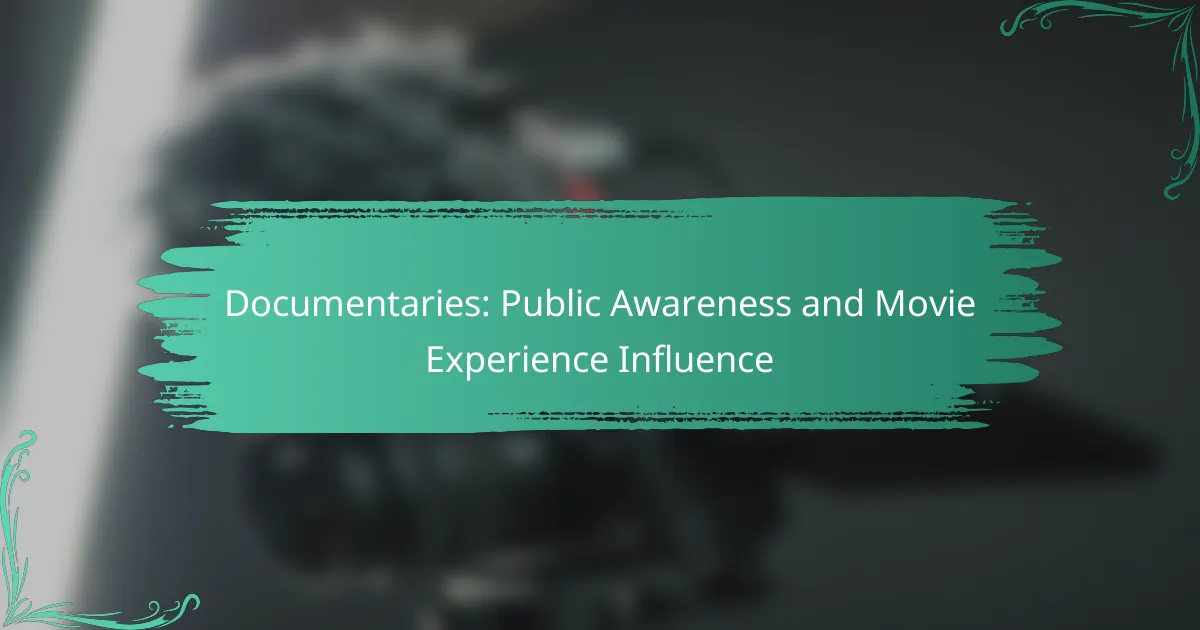Documentaries play a crucial role in raising public awareness by presenting compelling narratives that highlight pressing social issues and inspire action. By blending factual storytelling with real-world topics, they evoke strong emotional responses and enhance the overall movie experience. Through thorough research and engaging insights, filmmakers can create impactful documentaries that inform and motivate audiences to engage with critical issues.

How do documentaries raise public awareness in the United States?
Documentaries raise public awareness in the United States by presenting compelling narratives that highlight social issues, educate viewers, and inspire action. They serve as powerful tools for informing the public about critical topics, often leading to increased engagement and advocacy.
Impact of social issues
Documentaries often focus on pressing social issues such as climate change, racial inequality, and public health crises. By showcasing real-life stories and expert insights, these films can shift public perception and motivate individuals to take action. For instance, a documentary addressing environmental concerns can lead to heightened awareness and community initiatives aimed at sustainability.
Moreover, documentaries can influence policy changes by bringing attention to overlooked problems. When viewers connect emotionally with the subjects, they are more likely to support movements or legislation that address these issues.
Case studies of successful documentaries
Several documentaries have made significant impacts on public awareness in the U.S. “Blackfish,” which examines the treatment of orcas in captivity, sparked widespread outrage and led to changes in policies regarding marine parks. Similarly, “An Inconvenient Truth” played a crucial role in raising awareness about climate change, influencing public discourse and leading to increased advocacy for environmental policies.
These case studies illustrate how effective storytelling can amplify important messages and mobilize viewers to engage with social issues actively.
Engagement through storytelling
Effective documentaries utilize storytelling techniques to captivate audiences and foster emotional connections. By presenting relatable characters and compelling narratives, filmmakers can draw viewers into complex issues, making them more accessible and understandable. This approach encourages viewers to reflect on their own beliefs and actions regarding the topics presented.
Additionally, interactive elements such as social media campaigns and community screenings can enhance viewer engagement. By encouraging discussions and sharing personal experiences, documentaries can create a sense of community around the issues, further amplifying their impact on public awareness.

What are the effects of documentaries on movie experiences?
Documentaries significantly shape movie experiences by providing viewers with factual narratives that can evoke strong emotional responses. They often blend storytelling with real-world issues, enhancing the overall impact of the viewing experience.
Enhanced viewer empathy
Documentaries often foster enhanced viewer empathy by presenting real-life stories and struggles that resonate on a personal level. By showcasing diverse perspectives, they allow audiences to connect emotionally with subjects they may not encounter in their daily lives.
For instance, a documentary about climate change can illustrate the personal stories of those affected by environmental disasters, prompting viewers to feel compassion and urgency. This emotional engagement can lead to increased awareness and a desire to take action on social issues.
Influence on audience perceptions
Documentaries can significantly influence audience perceptions by framing issues in specific ways that shape understanding and attitudes. The way a documentary presents information—through visuals, interviews, and narrative structure—can lead viewers to adopt particular viewpoints or challenge existing beliefs.
For example, a documentary that highlights the struggles of marginalized communities can shift public perception, encouraging empathy and advocacy. However, it’s essential for viewers to critically assess the content, as documentaries can also present biased perspectives depending on the filmmakers’ intentions.

How can filmmakers create impactful documentaries?
Filmmakers can create impactful documentaries by focusing on compelling storytelling, thorough research, and engaging expert insights. These elements work together to inform and inspire audiences, fostering a deeper understanding of the subject matter.
Research and topic selection
Choosing the right topic is crucial for a documentary’s impact. Filmmakers should select subjects that resonate with current social issues or untold stories that evoke curiosity. Conducting extensive research helps identify gaps in existing narratives and ensures a well-rounded perspective.
Consider exploring topics that have personal significance or community relevance. This connection can enhance the emotional engagement of the audience, making the documentary more relatable and powerful.
Effective narrative techniques
Utilizing strong narrative techniques is essential for maintaining viewer interest. Filmmakers should structure their documentaries with a clear beginning, middle, and end, creating a compelling arc that guides the audience through the story. Techniques such as foreshadowing and cliffhangers can enhance suspense and engagement.
Incorporating visual storytelling elements, like striking imagery and dynamic editing, can also elevate the narrative. A well-crafted documentary often balances facts with emotional resonance, ensuring that viewers not only learn but also feel connected to the subject.
Utilizing expert interviews
Expert interviews add credibility and depth to documentaries. Filmmakers should seek out knowledgeable individuals who can provide unique insights and perspectives on the topic. This can include academics, practitioners, or those with personal experiences related to the subject matter.
When conducting interviews, it’s important to prepare thoughtful questions that encourage detailed responses. Filmmakers should also consider the diversity of voices represented, as this can enrich the narrative and appeal to a broader audience. Engaging storytelling through interviews can significantly enhance the documentary’s overall impact.
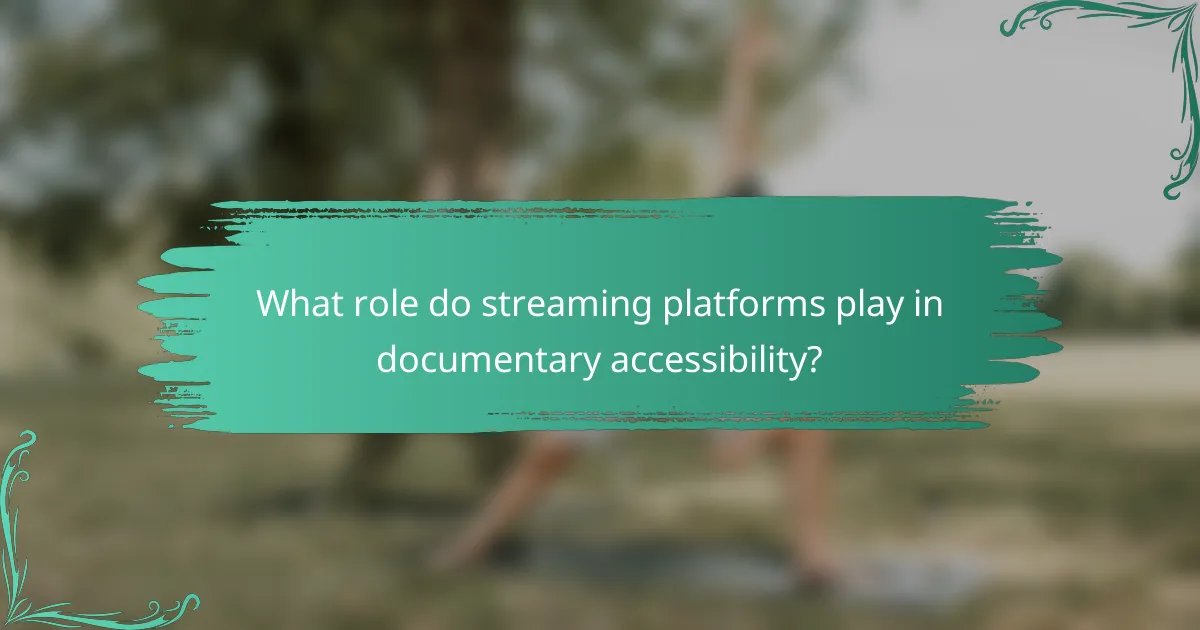
What role do streaming platforms play in documentary accessibility?
Streaming platforms significantly enhance documentary accessibility by providing a wide array of titles to viewers around the globe. They allow users to watch documentaries on-demand, breaking geographical and financial barriers that traditional media often impose.
Popular platforms for documentaries
Several streaming services are well-known for their extensive documentary libraries. Platforms like Netflix, Amazon Prime Video, and Hulu offer a diverse selection, ranging from nature and science to social issues and historical narratives. Specialized services such as CuriosityStream and DocuBay focus exclusively on documentary content, catering to niche audiences.
These platforms often produce original documentaries, which can attract subscribers and enhance their reputations as leaders in documentary filmmaking. For example, Netflix has gained acclaim for its original documentaries like “13th” and “Our Planet,” which have sparked significant public discussions.
Subscription trends in the US
In the United States, subscription trends indicate a growing interest in documentary content among viewers. Many households are shifting from traditional cable to streaming services, with a notable increase in subscriptions to platforms that feature documentaries prominently. Reports suggest that a significant portion of streaming subscribers watch documentaries regularly, highlighting their popularity.
As competition among streaming services intensifies, platforms are likely to invest more in documentary production to attract and retain subscribers. This trend suggests that viewers can expect an even broader range of documentary content in the coming years, making it easier to find topics of interest.
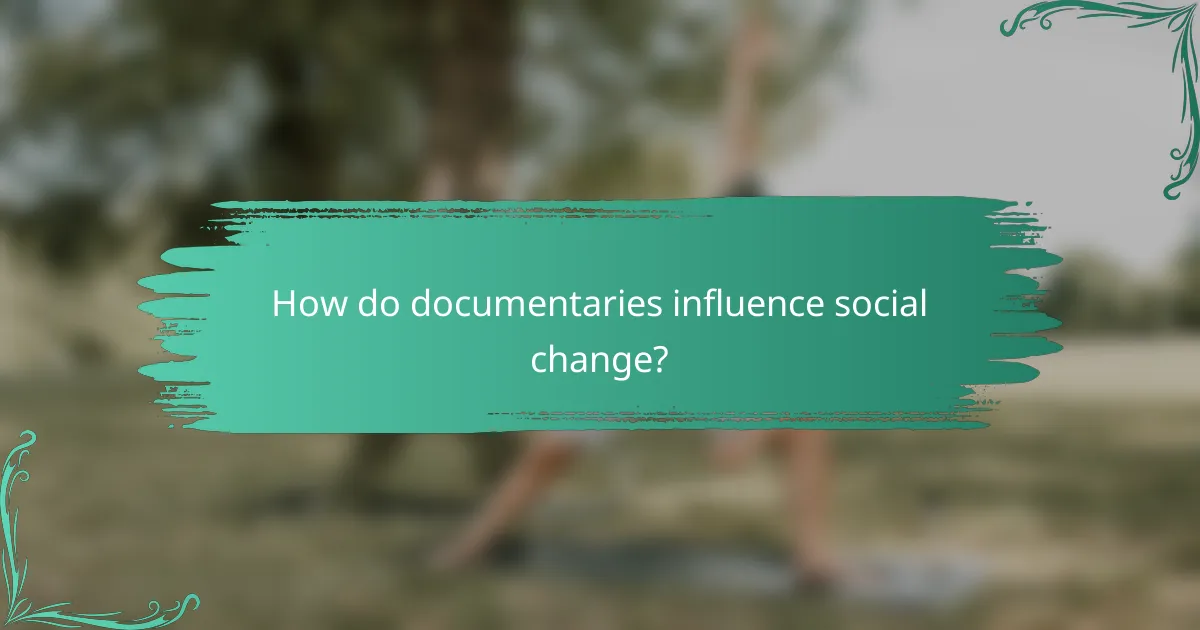
How do documentaries influence social change?
Documentaries influence social change by raising awareness about critical issues and inspiring viewers to take action. Through storytelling and factual representation, they can shift public perception and motivate community involvement.
Awareness campaigns
Documentaries often serve as powerful tools for awareness campaigns by highlighting social, environmental, or political issues. They can reach diverse audiences, making complex topics accessible and relatable. For example, a documentary on climate change can illustrate its impacts through personal stories, prompting viewers to reconsider their habits.
To maximize impact, awareness campaigns should integrate social media and community screenings. Engaging with audiences through discussions or Q&A sessions can deepen understanding and encourage grassroots movements. Effective campaigns often include clear calls to action, such as signing petitions or participating in local initiatives.
Community engagement initiatives
Community engagement initiatives leverage documentaries to foster dialogue and collaboration among local groups. By screening films in community centers or schools, organizers can create spaces for conversation about shared challenges and potential solutions. This approach often leads to collective action and stronger community ties.
Successful initiatives typically involve partnerships with local organizations, ensuring that the documentary’s message resonates with the community’s specific context. For instance, a film addressing food insecurity can lead to the establishment of community gardens or food drives. Engaging local leaders in discussions can also amplify the documentary’s message and encourage sustained involvement.
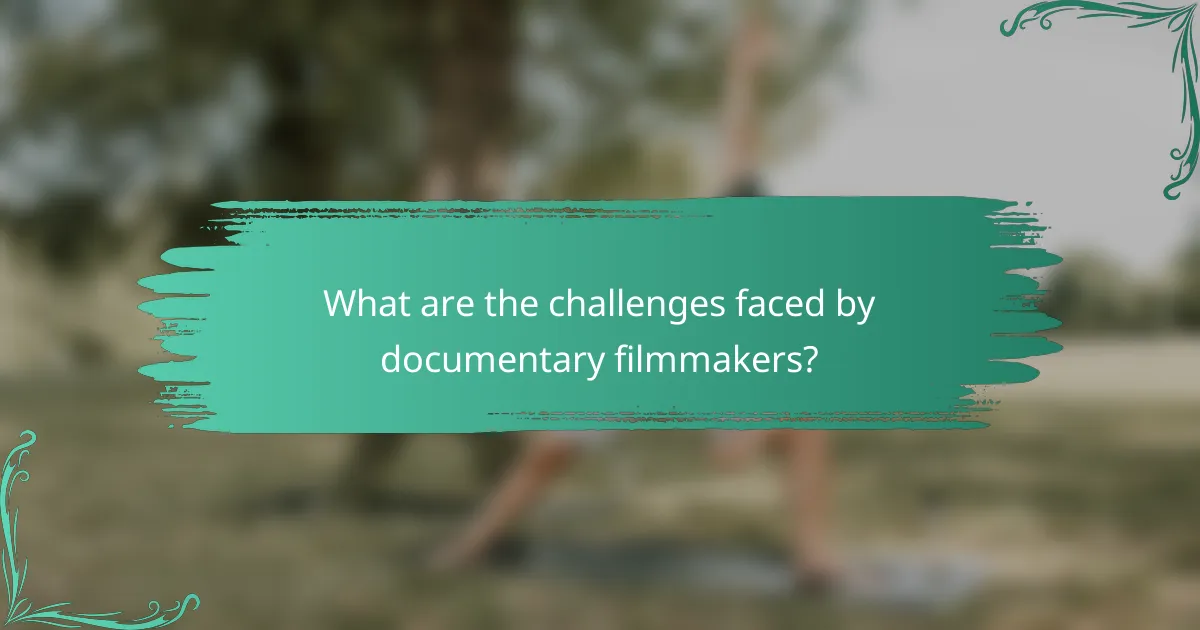
What are the challenges faced by documentary filmmakers?
Documentary filmmakers encounter several significant challenges that can impact their projects, including funding difficulties and distribution obstacles. These hurdles can affect the quality, reach, and overall success of their films.
Funding and budget constraints
Securing funding is one of the primary challenges for documentary filmmakers. Many rely on grants, crowdfunding, or sponsorships, which can be unpredictable and often come with strict conditions. Budgets can vary widely, but many documentaries operate on limited financial resources, which can restrict production quality and scope.
Filmmakers should prioritize creating a detailed budget that outlines all potential costs, including equipment, travel, and post-production. This clarity can help attract investors or grantors who want to see a well-thought-out financial plan.
Distribution hurdles
Once a documentary is completed, filmmakers often face distribution hurdles that can limit audience reach. Traditional distribution channels, such as theaters and television networks, may be difficult to access, especially for independent filmmakers. Digital platforms have emerged as alternatives, but they also come with their own challenges, including competition and platform fees.
To navigate distribution effectively, filmmakers should consider multiple avenues, such as film festivals, online streaming services, and social media campaigns. Building a strong online presence and networking within the industry can also enhance visibility and increase the chances of successful distribution.
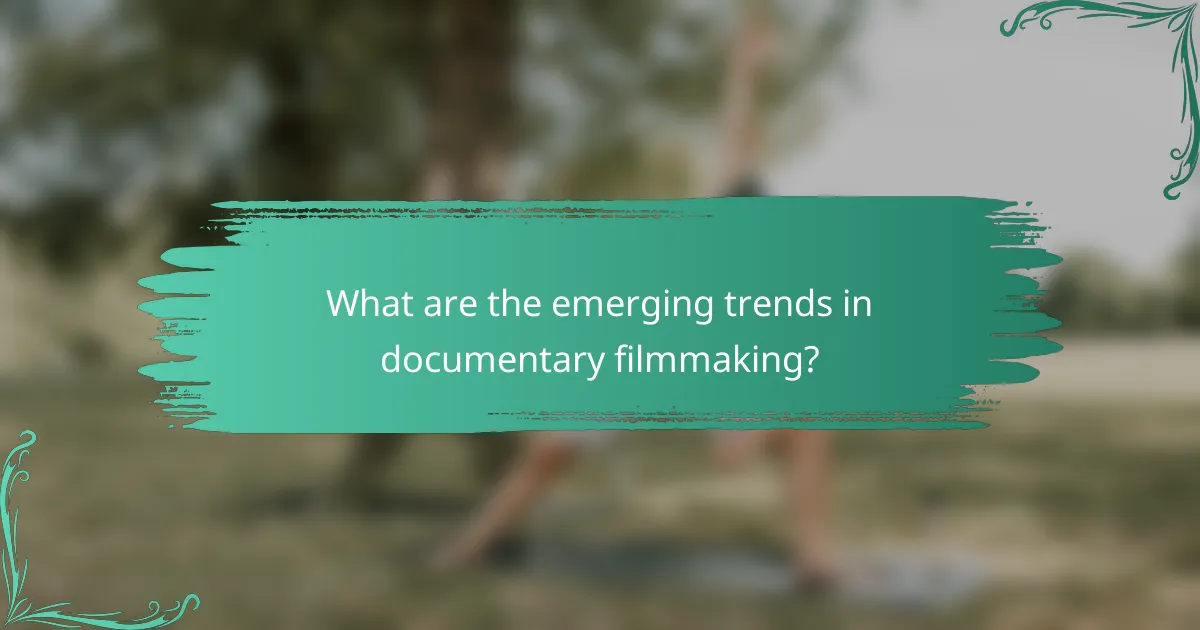
What are the emerging trends in documentary filmmaking?
Emerging trends in documentary filmmaking include the rise of interactive formats, increased use of technology, and a focus on social issues. These trends reflect changing audience preferences and advancements in digital media, allowing filmmakers to engage viewers in innovative ways.
Interactive documentaries
Interactive documentaries allow viewers to engage with content actively, often through choices that influence the narrative. This format can enhance the storytelling experience by making the audience feel like participants rather than passive observers.
Filmmakers can use various platforms to create interactive documentaries, such as web-based applications or virtual reality environments. For instance, projects like “Bear 71” and “The Enemy” have successfully integrated interactivity, enabling users to explore different perspectives and outcomes.
When creating interactive documentaries, consider user experience and accessibility. Ensure that the interface is intuitive and that the content remains engaging without overwhelming the viewer. Balancing interactivity with a coherent narrative is crucial to maintaining audience interest.
